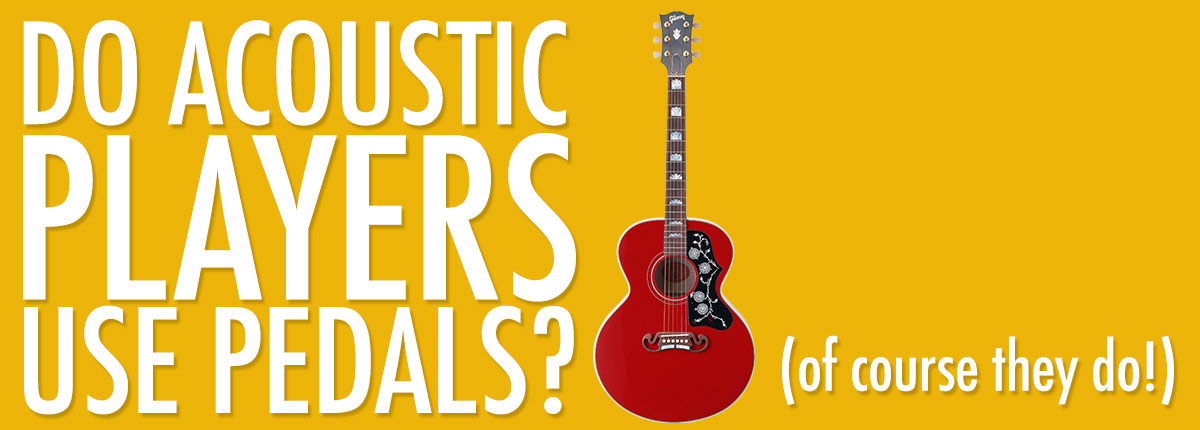
By Matt Gose
Posted 01/25/2021
Achieving quality acoustic tone live can be a major headache. The robust, angelic tone wafting through your bedroom suddenly falls flat in a crowded bar, washes out through the house sound system, or drowns beneath the swell of your backing band.
The solution? Guitar pedals. Blasphemous though it may seem, pedals can not only help shape and even preserve your guitar’s natural tone, they can add depth and character to your style.
Here are six essential pedals for acoustic guitar.
Tuner Pedal
In general, clip-on tuners are preferred for acoustic guitars. They’re small, portable, and can be used anywhere. Generally speaking, they also provide the most accurate tuning.
However, when it comes to live gigs, there are a number of benefits to including a tuning pedal in your rig as well.
First, tuning pedals are discrete. Tune on the fly without having machinery sticking out from your headstock.
Second, tuning pedals can mute your guitar in-house, while you tune up — protecting the ears and nerves of your adoring fans.
Third, while not absolutely necessary, having two separate tuners can help you dial in your tuning more accurately, especially at the top of a new set. Adding a tuner pedal in conjunction with a clip-on tuner is great for accomplishing this.
EQ
After your tuner, the next crucial pedal is EQ. This is especially vital if your guitar doesn’t have one built in, but is a worthy investment even if it does. EQing allows you to shape the harmonic responses of your guitar in a given space while recouping some of the tonal loss from plugging in. It can also help reduce feedback or give your tone a boost over a murmuring crowd or roaring band.
Compression
Right behind EQ is Compression, which controls the dynamic range of your guitar. Instead of a volume range of 0-100, compression can set upper and lower limits. Soft, subtle playing will resonate clearly while hard strumming won’t blow peoples’ eardrums.
Compression can also help with sustain, a useful function, especially for more percussive playing styles.
A key feature to look for in choosing a compression pedal is a “blend” knob, which allows you to refine the mix between the original signal and the compressed signal.
Modulation
Moving away from the more practical pedals are the more expressive modulation effects. Modulation pedals can add serious character to your sound while also adding some fullness and variation. These effects essentially make a copy of your original signal, multiply it, augment it in some way, then send it out with the initial signal to your amp or PA.
Pedals like chorus, phase, and flange, are best used in moderation, especially with acoustic guitars. When properly dialed in, however, they can help make your solo acoustic act sound much larger and more textured.
Looper
Playing solo can feel both vulnerable and limited. A looper pedal can open up the potential for your live set. Essentially, looper pedals allow you to record small clips that will then continue to loop through the house while you play and record over them. Layer various parts to create a lush tapestry of sound. Or be your own accompanist by laying down a rhythm track that you can solo over. Looper pedals kick the door wide open for creative possibilities.
Delay/ Reverb
Finally, we arrive at delay and reverb pedals. One crucial element of acoustic guitar tone is resonance. When you play your guitar at home, you’re not only hearing the sound from the body of the guitar but from the sound bouncing off the walls of the room. One reason acoustic guitar tone can feel so flat in a live setting is that once you plug in, you can lose that natural reverb.
Adding a reverb pedal to your mix can help you reapply some of that natural resonance back into your amplified sound. Dial it in subtly to add depth and dimension to your sound, or saturate your tone to create a larger-than-life soundscape.
Delay pedals can serve a similar function to reverb, essentially duplicating the signal and immediately playing it back like an echo. This can be used in a number of ways, from simply contributing some more fullness to your playing, all the way to adding various textures and complex rhythmic components to your sound — almost like a short-wave loop pedal.
Preservation not Augmentation
Ultimately, adding pedals to your acoustic rig is more about preserving and boosting your guitar’s natural tone than it is about altering it. Though, of course, like all things guitar, you can always experiment until you find something you like that serves the song, the mood, the context, or just your current creative phase. When all is said and done, it’s really about furthering your creative and expressive potential.
